The Passage of the Secrets forward, page 3
Most of our pages have a lot of graphics. If all of them do not load, click the 'refresh' on the browser.
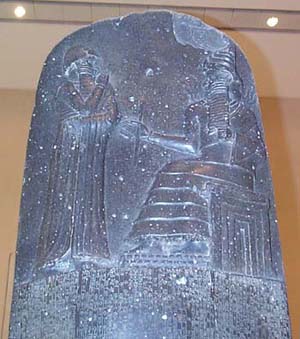 The Tables of Testimony have largely been forgotten but this
basalt monument was found in 1901 and is wonderfully engraved
with the law-code of Hamurrabi. However in accordance with
Qabalistic masters, the stone of the Mosaic tables was
said to be a divine sapphire called Schethiyd.
The text of the table can be viewed
Here and below.
This is a French site and it needs to be translated. Use
this ..translator
The Tables of Testimony have largely been forgotten but this
basalt monument was found in 1901 and is wonderfully engraved
with the law-code of Hamurrabi. However in accordance with
Qabalistic masters, the stone of the Mosaic tables was
said to be a divine sapphire called Schethiyd.
The text of the table can be viewed
Here and below.
This is a French site and it needs to be translated. Use
this ..translator
This tablet is not to be confused with the 10 commandments which are also of Egyptian origin, or the divers ordinances of Midianite law, but are rather more associated with the original Table of Destiny of the Anunnaki.
This tablet leaves little doubt of its advanced teachings.
In 1902, one discovered a basalt stele two height meters. It
represented Hammourabi, large king de Babylone, receiving
Shamash, the three hundred laws which were worth immortality to him.
Shamash is mentioned as being one of the gods who commissioned
Enoch as a priest.
In Zecharia Sitchin's Wars of Gods and Men, King Hammourabi is given the help of the Gods themselves. "Through the power of the great gods the king, beloved of the god Marduk, reestablished the foundations of Sumer and Akkad. Upon the command of Anu, and with Enlil advancing in front of his army, with the mighty powers which the great gods gave him, he was no match for the army of Emutbal and its king Rim-Sin. To defeat more enemies the god Marduk granted Hammourabi a "powerful weapon' called "Great power of Marduk".
Exerpt from the French page; (translated) The surgery is one of the chapters of the medicine akkadienne which is most badly known for us. We know by the Code HAMMOURABI (2000 front. JC) that the surgeons of this time skillfully places the broken members from there and that they did not hesitate to try serious operations whose sometimes the life depended even on their patient. But we are unaware of almost every part of their method. Their art, indeed, if it required anatomical sérieures knowledge, were not a science which is learned in the books. It was by the clinical experiment that the young doctor initiated himself with the operational secrecies of his Master. Only of rare passages where it is incidentally question " of the bronze knife, of the lancet or the lancet " can enable us to foresee the surgeon in the exercise of his art.
 " If a doctor, treating a free man for a serious affection
by means of the lancet, succeeds in curing it, or if,
by opening the nakaptu by means of a lancet, it cures
its eye to him, it will receive ten sicles money ".
This sum corresponds to 84 grams of money. However
the fees are proportional to the quality of the
patient. If it belongs to a a little lower class,
it pays only five sicles."
" If a doctor, treating a free man for a serious affection
by means of the lancet, succeeds in curing it, or if,
by opening the nakaptu by means of a lancet, it cures
its eye to him, it will receive ten sicles money ".
This sum corresponds to 84 grams of money. However
the fees are proportional to the quality of the
patient. If it belongs to a a little lower class,
it pays only five sicles."
This ancient archive is directly associated with the Emerald Tablet of Thoth-Hermes and, as detailed in alchemical records of Egypt, the author of the preserved writings was the biblical Ham, a great Archon of the Grail bloodline. He was the essential founder of the esoteric and arcane 'underground stream' which flowed through the ages, and his Greek name Hermes, was directly related to the science of pyramid construction, deriving from the word herma, which relates to a 'pile of stones'. Indeed the Great Pyramid is sometimes called the Sanctury of Thoth.
Outside Egypt and Mesopotamia, the table was known to Greek and Roman masters such as Homer, Virgil, Pythagoras, Plato and Ovid, while in much later times the 17th-century Stuart Royal Society of Britain was deeply concerned with the analysis and application of the sacred knowledge. In conjuction with the Knights Templar and with the Rosicrucian movement, the original Royal Society flourshed under prominent scholars such as Edmond Halley. Although admonished by the christian church authorities for entering the relms of heresy, with their insistance that the earth was in solar orbit, and because of their free association with Jews and Muslims, it was from the discoveries of these men that such enlightment as the law of Gravity and Boyle's Law became known to the public at large - discoveries that were directly attributed to the ancient archive of the hermetic table. (It is from the hermetic fusion of glass in early times that we derive the present-day term 'hermeticically sealed' glass.)
The secrets have long been withheld from the brethren
of modern Freemasonry whose leaders, for the past two centuries
or more, have elected to pursue a spurious and strategically
contrived allegorical ritual which teaches nothing of the
true art of the original Master Craftsman. In essence, the
Emerald tablet text relates to both the alchemy of metals
and the divine alchemy of human regeneration, along with
matters of science, astronomy and numerology. Once known to
Rosicrucian adepts as the
Tabula Smaragdina Hermetis,
the table of Ham (Chem-Zarathustra) was recorded as 'The most
ancient monument of the Chaldeans concerning the
Lapis Philosophorum (Philosophers Stone).
Lawrence Gardner Genesis of the Grail Kings
The tradition of the division of the ancient settled world into three branches is also in accord with what we know of the rise of civilizations.
Scholars have recognized an abrupt change in human culture about 11,000 B.C-the
time of the Deluge, according to our findings-and have named that era of domestication
Mesolithic (Middle Stone Age). Crita 7400 B.c.-exactly 3,600 years later-another
abrupt advancement has been recognized. Scholars have named it Neolithic (C "New
Stone Age”); but its principal feature was the switch from stone to clay and the
appearance of pottery. And then, “suddenly and inexplicably”- but exactly 3,600 years
later-there blossomed out (crita 3800 B.C.) in the plain between the Euphrates and
Tigris rivers the high civilization of Sumer. It was followed, crita 3100 B.C.,
by the civilization of the Nile River; and crita 2800 B.C., the third civilization
of antiquity, that of the Indus River, made its appearance. These were the three
regions allotted to mankind; of them evolved the nations of the Near East, Africa,
and Indo-Eumpe-a division faithfully recorded in the Old Testament’s Table of
Nations.
All that, Sumerian chronicles held, was the result of deliberate decisions by the
Anunnaki:
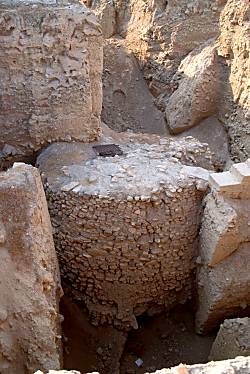 "The age of Jericho has been an enigma that has
continually buffled the scholars. They broadly divide man's
advancement (which spread from the Near East) into the
Mesolithic ("Middle Stone") Age, which saw the introduction of
agriculture and animal domestication circa 11,000 B.C.; a
Neolithic ("New Stone") Age 3,600 later, bringing with it
villages and pottery; and then, finally, Sumer's urban
civilization, again 3,600 years later. Yet there was Jericho,
an urban site occupied and built by unknowns sometime circa 8500
B.C., when man had not yet learned to lead even a village life..
"The age of Jericho has been an enigma that has
continually buffled the scholars. They broadly divide man's
advancement (which spread from the Near East) into the
Mesolithic ("Middle Stone") Age, which saw the introduction of
agriculture and animal domestication circa 11,000 B.C.; a
Neolithic ("New Stone") Age 3,600 later, bringing with it
villages and pottery; and then, finally, Sumer's urban
civilization, again 3,600 years later. Yet there was Jericho,
an urban site occupied and built by unknowns sometime circa 8500
B.C., when man had not yet learned to lead even a village life..
Jericho.... "was protected by a massive wall that surrounded the town (millennia before Joshua!).
"....Who could have built this advanced town so early, who had come to live in such a place, and whom it served as a fortified store city?
"The solution to this enigma lies, in our opinion, in the chronology of the "gods," not of men. It lies in the fact that the incredible first urban settlement in Jericho (from circa 8500 B.C. to 7000 B.C.) exactly matches the period which, according to Manetho, encompassed the reign of Thoth in Egypt (from about 8670 to 7100 B.C.) His accession, as we have seen from the Mesopotamian texts, followed the Peace Conference.
"They had come to Egypt, the Egyptians wrote, from Ta-Ur,
the 'Far/Foreign Land,' whose name Ur meant 'oldest' but could
have also been the actual place name - a place will known from
Mesopotamian and biblical records: the ancient city of Ur in
southern Mesopotamia. And the straits of the Red Sea, which
connected Mesopotamia and Egypt, were called Ta-Neter, the
'Place of the Gods,' the passage by which they had come to Egypt.
That the earliest gods did come from the biblical lands of Shem
is additionally borne out by the puzzling fact that the names
of these olden gods were of 'Semitic' (Akkadian) derivation.
Thus Ptah, which had no meaning in Egyptian, meant 'he who
fashioned things by carving and opening up' in the Semitic
tongues."
Zecharia Sitchin, The Wars of Gods and Men
The Egyptian Version of 'The Watchers'
"'Deliver thou the scribe Nebseni, whose word is truth, from the Watchers, who carry murderous knives, who possess cruel fingers, and who would slay those who are in the following of Osiris.'
May these Watchers never gain the mastery over me, and may I never fall under their knives!'
Other Unexplained Civilizations
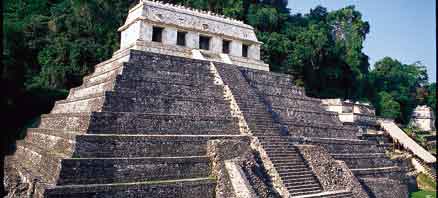 "The Legend of Votan,
who had built the first city that
was the cradle of Mesoamerican civilization, was written down
by Spanish chroniclers from oral Mayan traditions. The emblem
of Votan, they recorded, was the serpent; 'he was a descendant
of the Guardians, of the race of Can'. 'Guardians' was the
meaning of the Egyptian term Neteru (i.e., 'gods'). Can, studies
such as that by Zelia Nuttal (Papers of the Peabody Museum) have
suggested was a variant of Canaan who was (according to the
Bible) a member of the Hamitic peoples of Africa and a
brother-nation of the Egyptians."
"The Legend of Votan,
who had built the first city that
was the cradle of Mesoamerican civilization, was written down
by Spanish chroniclers from oral Mayan traditions. The emblem
of Votan, they recorded, was the serpent; 'he was a descendant
of the Guardians, of the race of Can'. 'Guardians' was the
meaning of the Egyptian term Neteru (i.e., 'gods'). Can, studies
such as that by Zelia Nuttal (Papers of the Peabody Museum) have
suggested was a variant of Canaan who was (according to the
Bible) a member of the Hamitic peoples of Africa and a
brother-nation of the Egyptians."
Zecharia Sitchin, When Time Began
"....The possibility, which we have already mentioned, that the earlier migrants might have been descendants of Cain, relates Nahuatlan beginnings to one of the first recorded forced deportations....
"....It is clear from Nahuatlan and Mayan legends that Quetzalcoatl (Kukulkan in Mayan lore) had come to their lands with a small band of followers, and that his eventual departure was a forced one - an exile imposed by the War God. We believe that his arrival was also the result of a forced departure, an exile, from his native land, Egypt. The date of that first event is a vital component of the Mesoamerican counts of Time.
"....The concept of Ages in Earth's history and prehistory was a basic tenet of the pre-Columbian civilizations of Mesoamerica. According to the Aztecs their Age or "Sun" was the fifth one and "began 5,042 years ago." While the Nahuatlan sources were not specific about how much longer this age was to last, the Mayan sources provided a more precise answer through the Long Count. The present "Sun," they said, will last precisely thirteen baktuns - 1,872,000 days from Point Zero. This represents a Grand Cycle of 5,200 "perfect years" of 360 days each.
"In The Mayan Factor Jose Arguelles concluded that each baktun date had acted as a milestone in the history and prehistory of Mesoamerica, as will the year A.D. 2012, in which the thirteen baktuns that begun in 3113 B.C. will be completed. He deemed the number 5,200 a key to understanding Mayan cosmogony and ages past and future.
"....In arriving at A.D 2012 as the end of the Fifth Sun, Jose Arguelles followed the present custom of dividing the 1,872,000 days by the actual number of 365.25 days in a solar year, resulting in the passage of only 5,125 years since the starting point in 3113 B.C. Fritz Buck on the other hand saw no need for such an adjustment, believing that the division should follow the Mayan 360 "perfect Year." According to Buck, the historic age through which the Aztecs and Mayans had lived was to last a perfect 5,200 years.
This number, like fifty-two, is connected with Thoth according to ancient Egyptian sources. Among them were the writings of an Egyptian priest whom the Greeks called Manetho (his hieroglyphic name meant "Gift of Thoth"). He recorded the division of monarchies into dynasties, including the divine and semidivine ones that preceded the pharaonic dynasties; he also provided lengths of reign for all them.
Corroborating legends and tales of the gods from other sources, the list by Manetho asserts that the seven great gods Ptah, Ra, Shu, Geb, Osiris, Seth, and Horus— reigned a total of 12,300 years. Then began a second divine dynasty headed by Thoth; it lasted 1,570 years. it was followed by thirty demigods who reigned 3,650 years. A chaotic time followed, a period of 350 years during which Egypt was disunited and in disarray. After that a person called Men established the first pharaonic dynasty. Scholars bold that this happened circa 3100 B.C.
We have held that the actual date was 3113 B.C., the starting point of the Mesoameflcan Long Count. It was then, we believe, that Marduk/RA, reclaiming lordship over Egypt, expelled Thoth and his followers from that land, forcing them into exile in another, distant, land. And if the preceding reign of Thoth himself (1,570 years) and of his appointed demigods (3,650 years) is tallied, the result is 5,220 years—A mere discrepancy of 20 years from the 5,200 perfect years that make up the Great Mayan Cycle of thirteen baktuns.
As with 52, so was 5,200 a “number of Thoth.” Zecharia Sitchin, When Time Began
Ancient structures all over the world were there for one reason. To predict the equinoxes and solstices. But they have been there long before recorded history began. They have one thing in common other than their megalithic size, each culture knew about the 'Flood'.
Whether it was the biblical flood of Noah, or another one, we cannot say, but there is ample physical evidence of a universal inundation, with the world-wide deluge described in more than a hundred flood-myths.
Along with Noah's flood were the Babylonian Utnapischtim of the Gilgamesh epic, the Sumerian Ziusudra, the Persian Jima, the Indian Manu, the Maya Coxcox, the Colombian Bochica, the Algonkin's Nanabozu, the Crows' Coyote, the Greek Deukalion and Pyrrha, the Chinese Noah Kuen, and the Polynesian Tangaloa. It is evident there was a world-wide deluge 19,000 years ago.( Their estimate)
Global doomsdays are conspicuous in the Hopi Indian legends, the Finnish Kalevala epic, the Mayan Chilam Balam and Popol Vuh, and in the Aztec calendar, the last of which predicts that our present civilization will be destroyed by "nahuatl Olin" or "earth movement," that is, devastation by earthquake. The devastation however, is more catastrophic than this...It would suggest a shift in the Earth's crust.
Such world-wide cataclysms appear in myth: the Egyptian Papyrus Ipuwer ("The sun set where it rose") the tomb of Senmut (showing Orion-Sirius painted in reverse position) the Finnish Kalevala ("the earth turned round like a potter's wheel"), the Popol Vuh (describing fire showering down from heaven) This indicates that our planet more than once has suffered world-wide catastrophe.
Due to Aztec cyclic theory this will become the fifth doomsday after the "death of the Jaguars," "the death of the Tempests," "the death of the Great Fire" (vulcanism), and the 'Great Deluge.' We are told that only the Inca (specifically the Sapai Inca, i.e. the ruler) could use the lower portions and the fertile valleys. The peons had to climb to the very peaks to cultivate the soil for their own subsistence. Noah's Boat also came to rest on a mountain top and there he planted a vineyard.
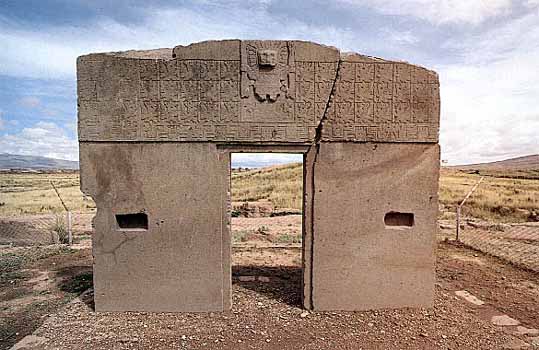 Just 12 miles southward of the southernmost tip of Lake Titicaca lie the remains
of Tiahuanaco, the site of a technologically advanced culture considered by many
archaeologists (romantic not orthodox) to be the oldest ruins in the world. Although
some misguided scholars have attributed the buildings of Tiahuanaco to the Incas, it
has now been established that the city was already in ruins when the first Incas
came upon the scene. This stone weighs 100 tons.
Just 12 miles southward of the southernmost tip of Lake Titicaca lie the remains
of Tiahuanaco, the site of a technologically advanced culture considered by many
archaeologists (romantic not orthodox) to be the oldest ruins in the world. Although
some misguided scholars have attributed the buildings of Tiahuanaco to the Incas, it
has now been established that the city was already in ruins when the first Incas
came upon the scene. This stone weighs 100 tons.
There are niches and geometrically accurate cutouts upon the lower part of the gate, especially on what is considered its back side . The most elaborate and enigmatic carvings are on the upper front side, facing due east. There, the arch of the gate has been carved to depict in relief a central flgure~ probably of Viracocha-flanked on each side by three rows of winged attendants ; the central figure and three rows have been positioned above a meandering geometric frame so carved as to snake over and under miniature images of Viracocha .
The writings of Posnansky have established that the carvings on the gate represented a twelve-month calendar of a year beginning on the day of the spring equinox in the southern hemisphere (September), yet a year where the other major points of the solar year-the autumn equinox and the two solstices-are also indicated by the positions and shapes of the depicted smaller images. It was, he concluded, a calendar of eleven months of thirty days each plus a great month,” a twelfth month of thirty-five days, adding up to a solar year of 365 days. When Time Began - Zecharia Sitchen
A twelve-month year beginning on the day of the spring equinox was, as we now know, first introduced at Nippur, in Sumer, circa 3800 B.C. The large monolithic Sun Gate of Tiahuanaco was evidently originally the centerpiece of the most important part of the Kalasasaya, the huge chief temple of Tiahuanaco. Its upper part is covered with a stupendously intricate sculpture in flat bas relief.
This has been described as a "calendar" almost as long as the monolithic gateway has been known to exist; thus the Sun Gate has also been called 'the Calendar Gate'.
"The Gate of the Sun,” archaeologists have discovered, stands at the northwest corner of what was a wall constructed of upright stone pillars that formed a rectangular enclosure within which the third most prominent edifice of the site.
The remains at Puma Punku hold another enigmatic clue to the amazing link between the structures at Lake Titicaca and the unusual temple to Ninurta that Gudea built. To the disbelief of the site’s excavators, they found that the megalithic builders had used bronze clamps, formed to fit T- shaped cutouts in adjoining stones, to hold together the huge stone blocks. Such a clamping method, and such a use of bronze, were unique to the Megalithic Age, having been found only at Puma Punku and at another site of cyclopean megaliths, Ollantaytambu, some forty-five miles northwest of Cuzco in the Sacred Valley.
Yet thousands of miles away, on the other side of the world, at Lagash
in Sumer, Gudea used the very same unique method and the very same unique
bronze clamps to hold together the stones that, imported from afar,
were used in the construction of the Eninnu. Recording in his inscriptions
the unusual use of stones and of metals, this is how Gudea lauded his
own achievements;
He built the Eninnu with stone, he made it bright with jewels;
with copper mixed with tin [bronze]
he held it fast.
It was a feat for which a Sangu Simug, a “priestly smith,” was brought over from the “Land of Smelting.” It was, we believe, Tiahuanacu in the Andes. When Time Began - Zecharia Sitchen
Where a narrow and rare plain fanned out from the southern shore of Lake Titicaca, the site of the once magnificent Tiahuanacu and its port (nowadays called Puma-Punku), only three principal monuments to its past dominate the landscape. The one at the southeastern part of the ruins is the hill called Akapana, an artificial hill (as Cieza de Leon had observed) that was assumed to have served as a fortress; it is now known to have been more like a stage-pyramid with built-in reservoirs, conduits, channels and sluices that indicate its true purpose: a facility for the separation and processing of ores. When Time Began - Zecharia Sitchen
In 1540 the Spanish chronicler, Pedro Cieza de Leon, visited the area and his description of the statues and monoliths compares very closely to what we see today. The site is at an altitude of 13,300 feet, which places it some 800 feet above the present level of Lake Titicaca. Most archaeologists agree that in the distant past Tiahuanaco was a flourishing port at the edge of the lake, which means that the water has receded almost 12 miles and has dropped about 800 feet since then. All concur that the lake is shrinking, due mainly to evaporation, since no rivers flow from it..
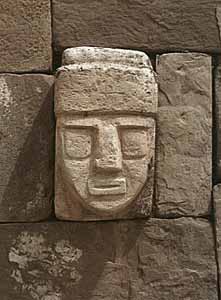 The figures depicted in the statuary have a rather square head with some
covering like a helmet; they have square eyes and a rectangular mouth. The stone
works at the ruins consist of such structures as the Gate of the Sun, a portal
carved from a single block of stone weighing 15 tons. The stone steps of the
Kalasasaya,('Gate of the Sun')
each of which is a rectangular block of stone about 30 feet wide. At the area called
Puma Punku, which is about 1 mile distant from the principal part of the ruins,
the gigantic stones are bluish-gray in color and appear to have been machined,
and they have a metallic ring when tapped by a rock. This feature is also found
in the Great Pyramid of Egypt. see..Pre-Inca
The figures depicted in the statuary have a rather square head with some
covering like a helmet; they have square eyes and a rectangular mouth. The stone
works at the ruins consist of such structures as the Gate of the Sun, a portal
carved from a single block of stone weighing 15 tons. The stone steps of the
Kalasasaya,('Gate of the Sun')
each of which is a rectangular block of stone about 30 feet wide. At the area called
Puma Punku, which is about 1 mile distant from the principal part of the ruins,
the gigantic stones are bluish-gray in color and appear to have been machined,
and they have a metallic ring when tapped by a rock. This feature is also found
in the Great Pyramid of Egypt. see..Pre-Inca
Mathmetical Genius used; They knew trigonometry and the measuring of angles (30, 60, 90 degrees) and their functions- They could calculate and indicate fractions, but do not seem to have known the decimal system nor did they apparently ever employ the duodecimal system though they were aware of it. Also, they determined-ages before Archimedes and the Egyptians the ratio of pi, the most important ratio between the circumference of the circle and its diameter, as 22/7, or, in our notation, 3.14+. They could calculate squares (and hence, square roots).
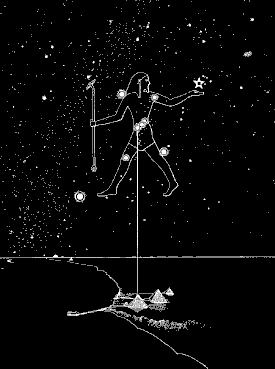 The Great Pyramid was constructed in the age of 'Leo'.
The pyramid was used to indicate solstices and equinoxes.
The pyramid is located at 29 degrees, 58 minutes, 51.06 seconds north
latitude, and 31 degrees, 9 minutes, and 0.0 seconds east longitude.
It's alignment is percise as to true North. The Great Pyramid is the most
accurately aligned structure in existence and faces true north with only 3/60th
of a degree of error. The position of the North Pole moves over time and the
pyramid was probably exactly aligned at one time.
The Great Pyramid was constructed in the age of 'Leo'.
The pyramid was used to indicate solstices and equinoxes.
The pyramid is located at 29 degrees, 58 minutes, 51.06 seconds north
latitude, and 31 degrees, 9 minutes, and 0.0 seconds east longitude.
It's alignment is percise as to true North. The Great Pyramid is the most
accurately aligned structure in existence and faces true north with only 3/60th
of a degree of error. The position of the North Pole moves over time and the
pyramid was probably exactly aligned at one time.
The three major Egytian Pyramids at Giza are aligned to the three stars in Orion's belt. The Pyramids mirrorThe Orion Constellation The pyramid positions on the ground are a reflection of the positions of the stars in the constellation Orion circa 10,400 B.C. Due to the angle of the sides of the pyramid vs. its latitude, it casts no shadow at noon during the spring equinox. The perimeter of the base divided by 100 = 365.24, the number of days in a year. {9131 PI * 4 / 100, accurate to 5 digits} The sum of the pyramid's twobase diagonals in PI = length of the Precession of the Equinoxes (~25827 years) Precession of the Equinoxes: The distance from the ceiling of the King's Chamber to the apex of the pyramid = 4110.5 PI. Which is the radius of a circle whose circumference = the precession of the equinoxes. {4110.5 * 2 * Pi= 25827} more stats; see The Great Pyramid
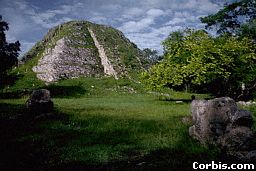 Mayan Pyramid;
"The sightlines in the existing structure have been excesively researched, and
undoubtedly include the principal points of the Sun - the equinoxes and solstices,
as well as some of the Moon's major points. Alignments with various stars are
also suggested, though not with Venus; that is odd, for in Maya codices the
movements of Venus are the principal subject. It is one of the reasons for believing
that the sightlines were not devised by Mayan astronomers, but were inherited by them
from previous eras.
Mayan Pyramid;
"The sightlines in the existing structure have been excesively researched, and
undoubtedly include the principal points of the Sun - the equinoxes and solstices,
as well as some of the Moon's major points. Alignments with various stars are
also suggested, though not with Venus; that is odd, for in Maya codices the
movements of Venus are the principal subject. It is one of the reasons for believing
that the sightlines were not devised by Mayan astronomers, but were inherited by them
from previous eras.
"The actual domain of Quetzalcoatl/Thoth was Mesoamerica and Central America, the lands of the Nahuatl-speaking and Mayan tribes; but his influence extended southward into the northern parts of the South American continent. Petroglyphs found near Cajamarca in the north of Peru that depict the Sun, the Moon, five pointed stars, and other celestial symbols of the serpent - the unmistakable emblem of Enki and his clan and specifically so of the deity known as the "Plumed Serpent." The petroglyphs also include depictions of astronomical viewing devices, one held by a person (priest?), as was customary in the Near East, and the other with the curved horns, as were the viewing devices erected in Egypt as the temples of Min.
There are other finds of petroglyphs along the Magdalena River in Colombia, representing the Hittite and Egyptian encounters.... In the tomb area of Holmul, Guatemala, a drawing of a pyramid is found.
"Incredible as it may sound, reference to petroglyphs with astronomical symbols is made in ancient Near Eastern writings. The Book of Jubilees, enlarging and fleshing out the biblical record of the generations that followed the Deluge, describes how Noah instructed his descendants by relating to them the tale of Enoch and the knowledge that was granted him. The narrative continued thus:
"In the twenty-ninth jubilee, in the first week, in the beginning thereof, Arpachshad took to himself a wife and her name was Rasu'eja, the daughter of Shushan, the daughter of Elam, and she bare him a son in the third year in this week, and he called his name Kainam. And the son grew, and his father taught him writing, and he went to seek for himself a place which he might occupy as a city for himself.
And he found a writing which former generations had carved on the rock, and he read what there was thereon, and he transcribed it and sinned as a result thereof; for it contained the teaching of the Guardians in accordance with which they used to observe the omens of the sun and moon and stars in all the signs of heaven."
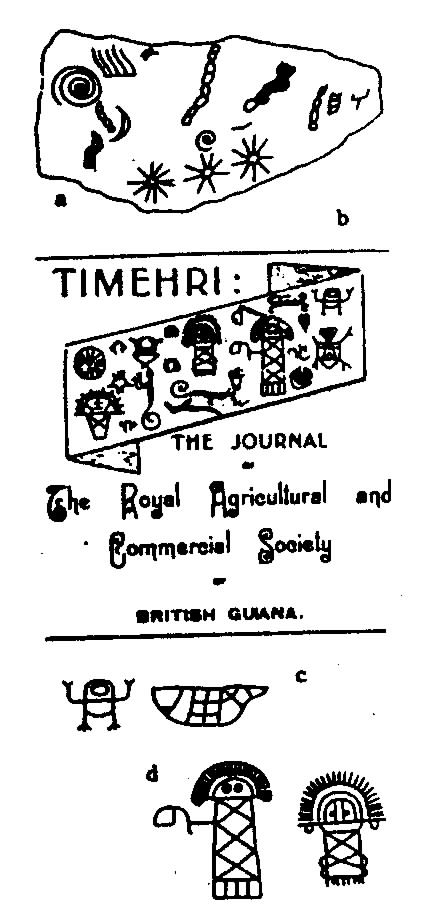 "The petroglyphs, we learn from
this mellennia-old text, were not mere graffiti; they were expressions of knowledge
of the "teachings of the Guardians" - the Anunnaki -" in accordance with which
they used to observe the omens of the Sun and the Moon and the
stars"; the petroglyphs were the "signs of heaven" of "former generations. ..see
Z.Sitchin
"The petroglyphs, we learn from
this mellennia-old text, were not mere graffiti; they were expressions of knowledge
of the "teachings of the Guardians" - the Anunnaki -" in accordance with which
they used to observe the omens of the Sun and the Moon and the
stars"; the petroglyphs were the "signs of heaven" of "former generations. ..see
Z.Sitchin
In the absence of written records, the petroglyphs that have been found in South America are precious clues to what the ancient inhabitants had known and seen. Many of them have been found in the funnel leading, in the continent’s northeastern part, into the Amazon basin and up that mighty river and its countless tributaries that begin in the distant Andes. The principal river of the Sacred Valley of the Incas, the Urubamba, is but a tributary of the Amazon River; so are other Peruvian rivers that flow eastward from sites whose mind-boggling remains indicate they were metallurgical processing centers. The known sites, only a fraction of what is there to be discovered if proper archaeological work were carried out, support the veracity of local traditions that people from across the Atlantic landed on those coasts and journeyed via the Amazon basin to obtain the gold and tin and other treasures of the Andes.
In what used to be called British Guiana alone, more than a dozen sites have been discovered where the rocks are covered with carved pictures. At a site near Karakananc in the Pacaraima mountains, the petroglyphs (above top left) depict stars with different numbers of rays or points (a Sumerian “first”), the crescent of the Moon and solar symbols, and what could have been a viewing device next to a stairway. At a place called Marlissa a long range of granite rocks along a river bank is covered with numerous petroglyphs; some of them adorned the cover of the journal of the Royal Agricultural and Commercial Society of British Guiana (Timehri, issue 6 of 1919) (top right). The peculiar person with raised hands and a helmetlike head with one large •eye” appears on the rock next to what looks like a large boat (bottom right)( We call him R2- D2.) The tightly clothed and haloed beings, shown many times over (bottom), are of giantlike proportions: in one instance thirteen feet tall and in another close to eight feet.
In neighboring Suriname, formerly Dutch Guiana, in the area of the Frederik Willem IV Falls, the petroglyphs are so numerous that researchers have found it necessary to assign numbers to the sites, to each group of petroglyph at each site, and to individual symbols within each group. Some of them would today be deemed to represent UFOs and their occupants, as would a petroglyph at site 13 at the Wonotobo Falls, where the previously seen depiction of tall and haloed beings has been converted into a domed contraption with a ladder coming down out of its opening; a mighty person is standing in that opening.
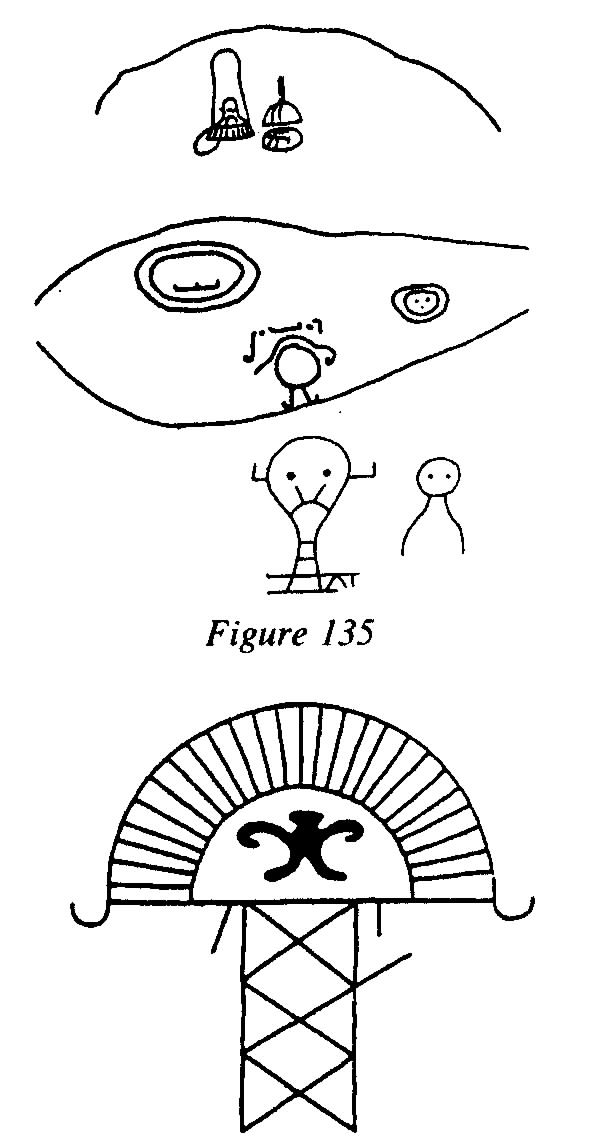 The message conveyed by such petroglyphs is that while some people were
seen arriving by boats, other godlike ones arrived in “flying saucers.”
At least two of the symbols among these petroglyphs can be recognized as Near
Eastern script-signs, and specifically so from Hittite inscriptions in Anatolia. One,
which appears as the determinative-sign next to a helmeted and horned face, unmistakably resembles
the hieroglyphic Hittite sign meaning “great” . This hieroglyphic sign was most often
used in Hittite inscriptions in combination with the sign for “king, ruler” to mean
“great king”; and exactly such a combined hieroglyph has been found several
times among the petroglyphs near the Wonotobo cataracts in Suriname.
The message conveyed by such petroglyphs is that while some people were
seen arriving by boats, other godlike ones arrived in “flying saucers.”
At least two of the symbols among these petroglyphs can be recognized as Near
Eastern script-signs, and specifically so from Hittite inscriptions in Anatolia. One,
which appears as the determinative-sign next to a helmeted and horned face, unmistakably resembles
the hieroglyphic Hittite sign meaning “great” . This hieroglyphic sign was most often
used in Hittite inscriptions in combination with the sign for “king, ruler” to mean
“great king”; and exactly such a combined hieroglyph has been found several
times among the petroglyphs near the Wonotobo cataracts in Suriname.
Petroglyphs, indeed, cover rocks large and small throughout South America; their
spread and images tell Man’s story in that part of the world, a story that is yet to be
fully deciphered and understood. For more than a hundred years explorers have
shown that the South American continent can be crossed by foot, or horseback,
by canoes and rafts.
Zecharia Sitchen - When time began
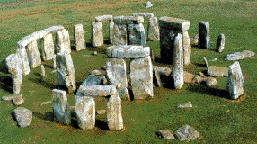 No view epitomizes Stonehenge more than the sight of the Sun’s rays
shining through the still-standing megaliths of the Sarsen Circle at sunrise on
summer’s longest day, when the Sun in its northern migration seems to hesitate,
stop, and begin to return. As fate would have it, only four of those great stone
pillars remain upright and connected at the top by the curving lintels, forming
three elongated windows through which we, as though we were Stonehenge’s
long-gone giant builders, can also view-and determine- the beginning of a new
annual cycle.
No view epitomizes Stonehenge more than the sight of the Sun’s rays
shining through the still-standing megaliths of the Sarsen Circle at sunrise on
summer’s longest day, when the Sun in its northern migration seems to hesitate,
stop, and begin to return. As fate would have it, only four of those great stone
pillars remain upright and connected at the top by the curving lintels, forming
three elongated windows through which we, as though we were Stonehenge’s
long-gone giant builders, can also view-and determine- the beginning of a new
annual cycle.
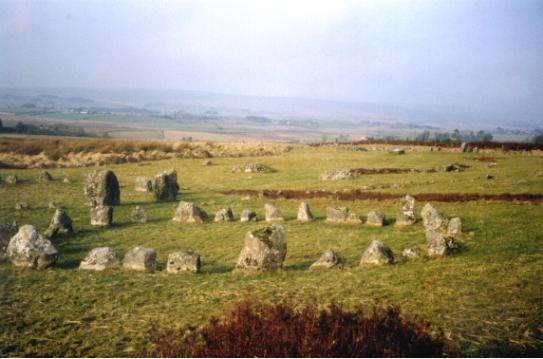 Beaghmore Stone Circles are located 8.5 miles north west of
Cookstown County Tyrone, on the south-east perimeter of the Sperrin
Mountains. While stone circles are fairly common in some parts of Ireland,
namely in the east, south and north, the most extensive concentration of
stone circles is to be found at Beaghmore.
Beaghmore Stone Circles are located 8.5 miles north west of
Cookstown County Tyrone, on the south-east perimeter of the Sperrin
Mountains. While stone circles are fairly common in some parts of Ireland,
namely in the east, south and north, the most extensive concentration of
stone circles is to be found at Beaghmore.
The site could mark a focal point for religious and/or social gatherings. Some archaeologists conclude that the circles have been constructed in relation to the rising of the sun at the solstice, or to record the movements of the sun and moon acting as observatories for particular lunar, solar or stellar events. Three of the stone rows point to the sunrise at the time of the solstice and another is aligned towards moonrise at the same period. Investigation of the site and the surrounding bog indicate that the area was occupied since Neolithic times through the Bronze Age. The Stone Circles and Cairn are atributed to the earlier part of the Bronze Age c. 2,000-1,200 BC.
 On the west coast of the Isle of Lewis, at Callanish, stands the awesome
collection of stone circles and rows of standing stones called the 'Hebrides'
Stonehenge'. Why so much time was spent by early man 4000 years ago
building these monuments no knows for sure, astronomical religious reasons
seem the most likely. You can find Standing Stones in every region of
Scotland, but the Northern Isle of Orkney is nothing less than a megalithic paradise.
On the west coast of the Isle of Lewis, at Callanish, stands the awesome
collection of stone circles and rows of standing stones called the 'Hebrides'
Stonehenge'. Why so much time was spent by early man 4000 years ago
building these monuments no knows for sure, astronomical religious reasons
seem the most likely. You can find Standing Stones in every region of
Scotland, but the Northern Isle of Orkney is nothing less than a megalithic paradise.
Stone Circles are a type of monument largely confined to the British Isles—although related stone settings (rows or horseshoes) were erected all along the Atlantic façade of western Europe during the period commonly known as the Megalithic Age. In Britain and Ireland some 1,300 of them have been identified, all built between about 3500 and 1200 BC. Most of the surviving examples come from the highland zones of both islands but they are by no means uncommon elsewhere. In fact, the most famous stone circles of all—Stonehenge and Avebury—are both in the lowlands.
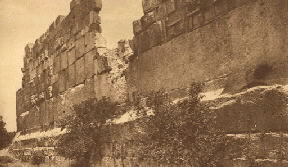 This article introduces and discusses new discoveries made in the
colossal ruins at Baalbek, Lebanon, and the possibility they are evidence
of a past supercivilization or, at least, technically advanced civilization of
“prehistory.” In Roman times it
was known as Heliopolis or City of the Sun. An example of how ancient is the site
can be found in that its holiest area (in pagan times) was the Temple of Baal-Jupiter
—a hybrid between the ancient Canaanite god Baal (lord) and the Roman Jupiter.
Moreover, this temple was built on a “tel” or ruin mound, indicating a place that
had long been held sacred, though what had caused this area to be significant or
“sacred” is unknown.
This article introduces and discusses new discoveries made in the
colossal ruins at Baalbek, Lebanon, and the possibility they are evidence
of a past supercivilization or, at least, technically advanced civilization of
“prehistory.” In Roman times it
was known as Heliopolis or City of the Sun. An example of how ancient is the site
can be found in that its holiest area (in pagan times) was the Temple of Baal-Jupiter
—a hybrid between the ancient Canaanite god Baal (lord) and the Roman Jupiter.
Moreover, this temple was built on a “tel” or ruin mound, indicating a place that
had long been held sacred, though what had caused this area to be significant or
“sacred” is unknown.
Questions constantly crop up concerning these blocks. Baalbek may become a focal point for the dichotomy being uncovered throughout the world today between the prehistoric past we assume existed and our earliest cultures of history. The massive and elegant Roman stonework and columns pale by comparison to the megaliths they were built upon. The temple very visibly incorporates into its foundation, stones of some 1,500 tons. They are some 68 x 14 x 14 feet! They are the largest worked stones on earth! It is a mystery how such stones could have been moved into place, even according to our science and engineering knowledge of today. It is also a fact the Romans did not use this type of stonework. see.. Baalbek
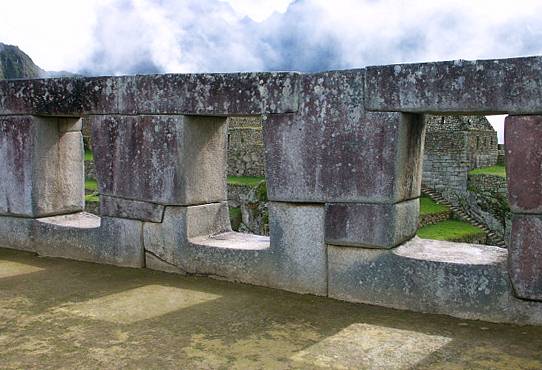 And as fate would have it, somewhere on the other side of the world,
another set of three windows in a massive structure of cyclopean stones-built,
local lore relates, by giants-also offers a breathtaking view of the Sun appearing
through white and misty clouds to direct its rays in a precise alignment. That other
place of the Three Windows, where the Sun also rises on a crucial calendrical day,
is in South America, in Peru.
And as fate would have it, somewhere on the other side of the world,
another set of three windows in a massive structure of cyclopean stones-built,
local lore relates, by giants-also offers a breathtaking view of the Sun appearing
through white and misty clouds to direct its rays in a precise alignment. That other
place of the Three Windows, where the Sun also rises on a crucial calendrical day,
is in South America, in Peru.
Is the similarity just a visual fluke, a mere coincidence? We think not.
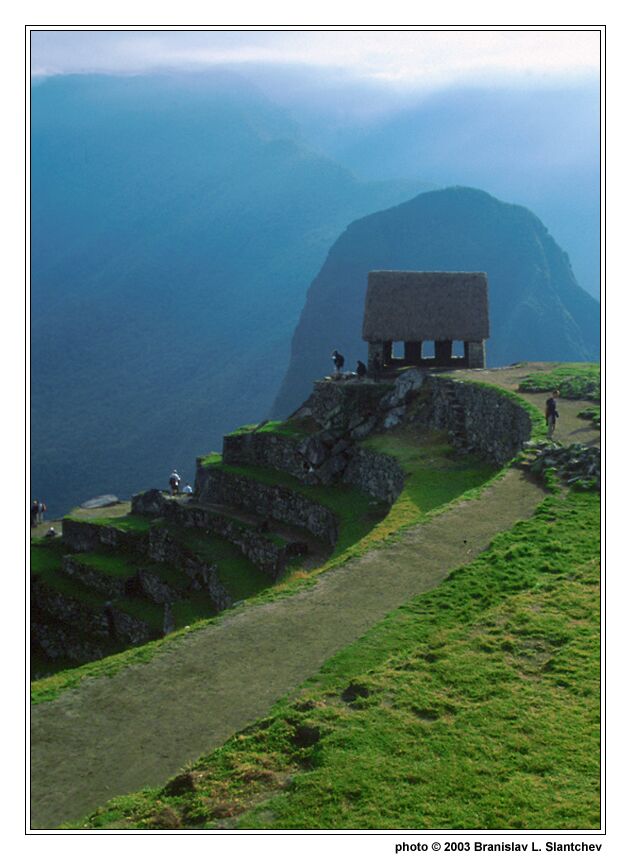 Nowadays the place is called Machu Picchu, so named after the sharp
peak that rises ten thousand feet at a bend of the Urubamba River on which
the ancient city is situated. So well hidden in the jungle and among the
endless peaks of the Andes, it eluded the Spanish Conquistadors and remained
a “lost city of the Incas” until discovered in 1911 by Hiram Bingham.
It is now known that it was built long before the Incas, and that its
olden name was Tampu-Tocco, ‘Haven of the Three Windows.” The place,
and its unique three windows, are featured in local lore regarding the origins
of the Andean civilization when the gods, led by the great creator Viracocha, placed the
four Ayar brothers and their four sister-wives in Tampu-Tocco. Three brothers emerged
through the three windows to settle and civilize the Andean lands; one of them founded
the Ancient Empire that preceded that of the Incas by thousands of years.
Nowadays the place is called Machu Picchu, so named after the sharp
peak that rises ten thousand feet at a bend of the Urubamba River on which
the ancient city is situated. So well hidden in the jungle and among the
endless peaks of the Andes, it eluded the Spanish Conquistadors and remained
a “lost city of the Incas” until discovered in 1911 by Hiram Bingham.
It is now known that it was built long before the Incas, and that its
olden name was Tampu-Tocco, ‘Haven of the Three Windows.” The place,
and its unique three windows, are featured in local lore regarding the origins
of the Andean civilization when the gods, led by the great creator Viracocha, placed the
four Ayar brothers and their four sister-wives in Tampu-Tocco. Three brothers emerged
through the three windows to settle and civilize the Andean lands; one of them founded
the Ancient Empire that preceded that of the Incas by thousands of years.
The three windows formed part of a massive wall constructed of cyclopean granite stones that-as at Stonehenge-were not native to the site, but hauled from a great distance across towering mountains and steep valleys. The colossal stones, carefully smoothed and rounded on their surfaces, were cut into numerous sides and angles as though they were soft putty. Each stone’s sides and angles fitted the sides and angles of all its adjoining stones; all these polygonal stones thus locked into one another like pieces of a jigsaw puzzle, tightly fitting without any mortar or cement and withstanding the not infrequent earthquakes in the area and other ravages of man and nature.
The Temple of the Three Windows, as Bingham named it, has only three walls: the one with the windows facing in an easterly direction, and two sidewalls as protecting wings. The western side is completely open, providing room for a stone pillar, about seven feet high; supported by two horizontally placed, carefully shaped stones, one on each side, the pillar precisely faces the central window. Because of a niche cut into the pillar’s top, Bingham surmised that it might have held a beam supporting a thatched roofing; but that would have been a unique feature in Machu Picchu, and we believe that the pillar here served the same purpose as the Heel Stone (at first) at Stonehenge or the Altar Stone (later on there), i.e., as the Seventh Pillar of Gudea to provide the line of sight. Ingeniously, the availability of three windows made possible three lines of sight-to sunrise on midsummer day, equinox day, and midwinter day
The structure of the three windows with the facing pillar made up the eastern part of what Bingham named, and scholars still call, the Sacred Plaza. Its other principal structure, also three-sided, has its longest wall on the Plaza’s northern end and is without a wall on its southern face. It too is made of cyclopean blocks of imported granite also held together by their polygonal shapes. The central north wall has been so constructed as to create seven false windows~trapezoidal cutouts that imitate the three windows but do not in fact cut through the stone wall. A massive rectangular stone monolith, measuring fourteen by five by three feet, lies on the structure’s floor below these false windows. Though the purpose of this structure has not been determined, it is still referred to as the Principal Temple, as Bingham named this structure.
Since the five-foot height of the prostrate stone did not let it serve
as a seat, Bingham speculated that it might have served as an offering table,
“a species of an altar; possibly offerings of food were placed on it, or it may
have been intended to receive mummies of the honored dead, which could
here be brought out and worshipped on days of festival.” Though such
customs are purely imaginary, the suggestion that the structure could
have been related to festival days-i.e. to the calendar-is intriguing. The
false seven windows have six markedly protruding stone pegs above
them, so that some kind of counting involving seven and six-as at the
Girsu in Lagash~~~~Cannot be ruled out.
Zecharia Sitchen -
When time began
More from the Book of Jubilees
"For in his days the angels of the Lord descended upon earth - those who are named The Watchers - that they should instruct the children of men, that they should do judgment and uprightness upon earth."
"According to the Book of Jubilees, the Watchers are the
sons of god (Genesis 6) sent from heaven to instruct the children
of men; some of them fell after they descended to earth and cohabited
with the daughters of men - for which act they were condemned
(so legend reports) and became 'fallen angels'. But
not all Watchers descended: those that remained are the holy
Watchers, and they reside in the 5th Heaven.
The 'Holy Watchers' were here to help man. They are
also described as 'civilizers'.
"Several fragments with a clear Qumranic cast (4Q286-287, 4Q385-389, 4Q390...) parallel Belial with the angels of MA&+EMOWT ('enmity'), while Jubilees introduces Mastema/Satan into its story of the spirits of the giants, the offspring of the fallen Watchers (Jubilees 10:8,11; see also 11:5,11; 17:16; 18:9,12; 19:28; 48:2,9,12,15).
Note that according to Jubilees, the angels of MA&+EMOWT would be the spirits of the giants, the offspring of the angel marriages, one tenth of whom become the servants of Mastema in leading astray and punishing humanity, while 4Q390 makes them the ones responsible for inspiring the sons of Aaron to pollute the Temple through illegitimate marriages and violence."
"According to the Book of Jubilees, Enoch...testified about the Watchers who had sinned with the daughters of men; he testified against them all." And it was to protect him from the revenge of the sinning angels of the Lord, that 'he was taken from amongst the children of men, and was conducted into the Garden of Eden." - 1 Enoch 10:3-8 Enoch
Non-bias researchers have this it say;
"...Man and his early civilizations had a profoundly different mentality from our own, that in fact men and women were not conscious as are we, were not responsible for their actions, and therefore cannot be given the credit or blame for anything that was done over these vast millennia of time; that instead each person had a part of his nervous system that was divine, by which he was ordered about like any slave, a voice or voices which indeed were what we call volition and empowered what they commanded and were related to the hallucinated voices of others in a carefully established hierarchy."
"...The astonishing consistency from Egypt to Peru, from Ur to Yucatan, wherever civilizations arose, of death practices and idolatry, of divine government and hallucinated voices, all are witness to the idea of a different mentality than our own."
"The gods were in no sense 'figments of the imagination' of anyone. They were man's volition. They occupied his nervous system, probably his right hemisphere, and from stores of admonitory and receptive experience, transmuted this experience into articulated speech which then 'told' the man what to do."
"Throughout Mesopotamia, from the earliest times of
Sumer and Akkad, all lands were owned by gods and men were their
slaves. Of this, the cuneiform texts leave no doubt whatever.
Each city-state had its own principal god, and the king was
described in the very earliest written documents that we have as
'the tenant farmer of the god'."
Julian Jaynes, The Origin of Consciousness in the
Breakdown of the Bicameral Mind
"... The Akkadians called their predecessors Shumerians, and spoke of the Land of Shumer. (Sumer)
"It was, in fact, the biblical Land of Shin'ar. It was
the land whose name - Shumer - literally meant the Land of the
Watchers. It was indeed the Egyptian Ta Neter - Land of the
Watchers, the land from which the gods had come to Egypt."
Zecharia Sitchin, The Stairway to Heaven
"Ptah and the other gods were called, in Egyptian, Ntr -
'Guardian, Watcher'."
Zecharia Sitchin, The Wars of Gods and Men
During the fabled "First Time, Zep Tepi, when the gods ruled in their country: they said it was a golden age during which the waters of the abyss receded, the primordial darkness was banished, and humanity, emerging into the light, was offered the gifts of civilization. They spoke also of intermediaries between gods and men - the Urshu, a category of lesser divinities whose title meant 'the Watchers'. And they preserved particularly vivid recollections of the gods themselves, puissant and beautiful beings called the Neteru who lived on earth with humankind and exercised their sovereignty from Heliopolis and other sanctuaries up and down the Nile.
Some of these Neteru were male and some female but all
possessed a range of supernatural powers which included the
ability to appear, at will, as men or women, or as animals,
birds, reptiles, trees or plants. Paradoxically, their words
and deeds seem to have reflected human passions and
preoccupations. Likewise, although they were portrayed as
stronger and more intelligent than humans, it was believed that
they could grow sick - or even die, or be killed - under
certain circumstance."
Graham Hancock, Fingerprints of the Gods
"It was from that planet [Nibiru], the Sumerian texts
repeatedly and persistently stated, that the Anunnaki came to
Earth. The term literally means 'Those Who from Heaven to Earth
Came.' They are spoken of in the Bible as the Anakim, and in
Chapter 6 of Genesis are also call Nefilim, which in Hebrew
means the same thing: Those Who Have Come Down, from the Heavens
to Earth."
Zecharia Sitchin, Genesis Revisited
Scientific proof of The Star Burst and more
Modern scientific logic of the 'creation'.
Biocosmology
Exerpt..Quantum Reality
Space-time and the universe are one manifold, which is also a lattice of interactions. The duality of wave and particle results in quantum uncertainty, because energy, being the same as frequency, can only sampled over an extended time. Within the bubble of of uncertainty, anything possible can happen and everything does, even in the vacuum.
 "In our galaxy, about 1,300 light years away and 12,300
years ago, a supernova exploded in the constellation Vela,
forming the Gum Nebula. People on earth saw the explosion about
11,000 years ago as a star of magnitude -10, as bright as a
7-day old Moon. Now we on earth see the remnants as a shell with
radius about 1,000 light years, covering 30 to 60 degrees in
the sky. (The sun and moon each cover about half a degree.)"
Kaufmann - Universe (4th ed) - Freeman 1994
"In our galaxy, about 1,300 light years away and 12,300
years ago, a supernova exploded in the constellation Vela,
forming the Gum Nebula. People on earth saw the explosion about
11,000 years ago as a star of magnitude -10, as bright as a
7-day old Moon. Now we on earth see the remnants as a shell with
radius about 1,000 light years, covering 30 to 60 degrees in
the sky. (The sun and moon each cover about half a degree.)"
Kaufmann - Universe (4th ed) - Freeman 1994

|

|
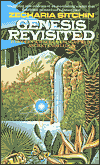
|
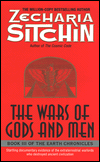
|
 |
 |

|
 |
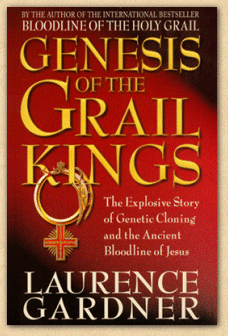
|
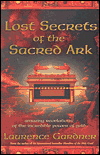
|
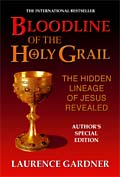
|
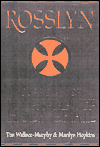 |
Sign our guest book.
View My Guestbook
 Sign My Guestbook
Sign My Guestbook NO PART OF THIS SITE MAY BE COPIED OR REPRODUCED, IN WHOLE OR IN PART,
WITHOUT THE EXPRESS WRITTEN PERMISSION OF THE WEBMASTER...
© COPYRIGHT 1999 - 2009 c.i.c. ALL RIGHTS RESERVED.
This site is protected by the "Fair Use" section of the Copyright Law. ie: Educational
If your site is not Strictly Masonic in nature,
We kindly ask that you do not link to
this site without permission of the Web Master or under the guidelines set forth here
...
see Legal Issues
This page has been visited times Since November 31st, 1999